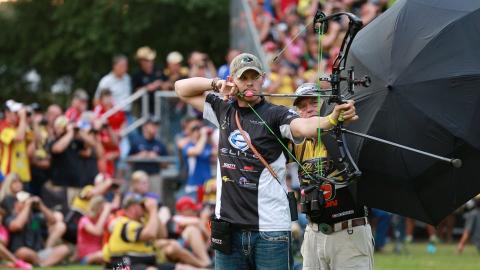Ernie Calandrelli of Youngstown, New York, can’t remember a time when he wasn’t a Mossy Oak ProStaffer. He started helping Dick Kirby, the founder of Quaker Boy Calls 40 years ago, and just retired after being with Quaker Boy full time for 32 years. Ernie has taken customers and outdoor writers hunting and fishing for Quaker Boy during those many years. Now that he’s retired, Calandrelli has been doing more hunting and fishing.
5-Acre Kansas Buck Taken Near a House
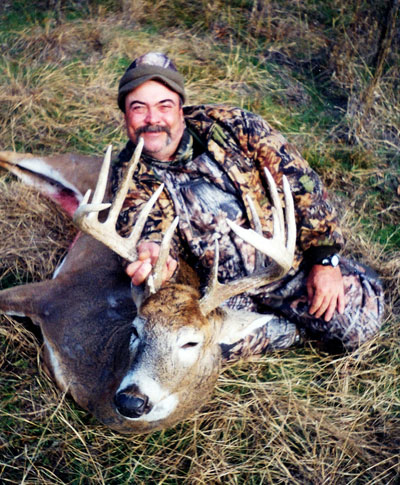 One of my favorite places to hunt deer is in Kansas, and 2018 was my twentieth year to hunt in Kansas. I hunt with friends I’ve made in Kansas. A friend of mine has a lease there. Another friend has a small 5-acre Kansas farm, but it’s the right 5 acres. I took a buck on that 5-acre lot three years ago that scored 160 inches. I hadn’t planned to hunt that 5-acre plot but instead was going to hunt another larger property. However, when we went to that land, the farmer who owned that property was cutting the cornfield, which meant I couldn’t get in there. I asked my friend, “What are we going to do now?” He answered, “Let’s just go to the 5-acre farm.”
One of my favorite places to hunt deer is in Kansas, and 2018 was my twentieth year to hunt in Kansas. I hunt with friends I’ve made in Kansas. A friend of mine has a lease there. Another friend has a small 5-acre Kansas farm, but it’s the right 5 acres. I took a buck on that 5-acre lot three years ago that scored 160 inches. I hadn’t planned to hunt that 5-acre plot but instead was going to hunt another larger property. However, when we went to that land, the farmer who owned that property was cutting the cornfield, which meant I couldn’t get in there. I asked my friend, “What are we going to do now?” He answered, “Let’s just go to the 5-acre farm.”
I had put a ladder stand out on that 5-acre plot that contained hardwoods, was surrounded by prairie and was in the middle of nothing except for a house with a driveway. The Kansas prairie was often difficult hunting. The only way I could be successful there was to find a tree that would hold me, and I’d climb up in it. There was CRP land around that 5 acres with plum thickets and soybean fields surrounding the CRP land. The spot I’d chosen was close to the bedding area that the deer used in the CRP land. I didn’t know much about the 5-acre farm, although we had trail cameras set up in there and saw some pictures of some nice-sized bucks. However, the fact that I didn’t know that much about the land didn’t bother me, because in three consecutive years, I took nice bucks there that had never shown up on the trail cameras.
I was hunting with a TenPoint crossbow within sight of the house and the driveway, where probably no one ever would consider hunting. A couple of does came into my stand that morning. A buck that would score about 130 inches was chasing and harassing those does. I was hunting the second week of November, 2015, which was the rut time there. I kept watching the buck when suddenly he got nervous and looked across the road. When I turned to see what he was looking at, I saw this really nice buck walk across a driveway right behind the house and into the woods where I was hunting. The big buck ran the little 130-inch buck out of the woods. I grunted a couple of times to stop the bigger buck. However, before I could get on that bigger buck with my crossbow, the does returned. Like an idiot, I let this buck walk past me, within easy shooting distance, thinking I might not want him, although this was the sixth day I’d been deer hunting there.
When the buck was standing on top of a sand hill, the does filtered back into my stand site, and the 130-inch buck followed them. I was looking at the buck on the sand hill with my binoculars and saw that he had 12-inch G2s, and I said to myself, “That big buck has a heck of a rack. I can’t believe I let him walk right under me, and I didn’t take a shot. He is a shooter buck.”
I grunted a few times with a Quaker Boy Brawler Grunt Call and watched as that buck’s hair stood up. Then he whirled and charged toward the 130-inch buck, bringing hurt with him, and ran the 130-inch buck off this second time. The big buck then stood still – about 12 steps from my stand. This time I had enough sense to recognize this big 160-inch buck as a very nice one. I quickly squeezed the trigger on my crossbow and hit the buck right behind his front shoulder. He ran back to the top of the sand hill and then fell over, stone cold dead.
When my buddy returned to pick me up and saw the buck, he asked, “Where did he come from - I have no pictures of that buck.” Later we talked to one of my friend’s neighbors who said he might have one photo of the 160-inch buck from weeks before. That was the only buck I ever took off that 5 acres.
I realized from this hunt that no one thinks of hunting behind his or her house. But in Kansas I learned that I didn’t have to hunt in remote areas of several thousands of acres to take a big buck. You may want to consider scouting and hunting small properties where no one hunts like this 5-acre patch of woods that included a farmer’s house.
2016 Kansas Buck Taken on a Doe Hunt
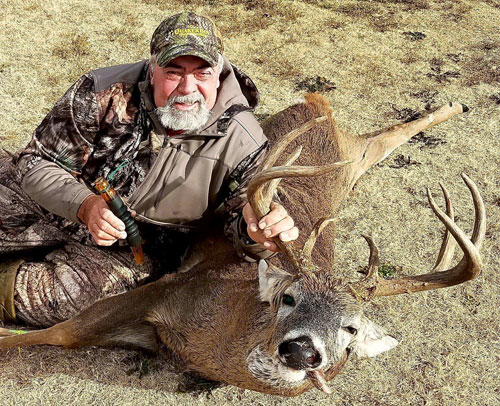 I was hunting on one of my buddy’s 400-acre Kansas lease in 2016. For six days, I passed up a number of nice bucks that probably would have been shooter bucks in New York State where I lived. On this morning, I went to a place we called the Tripod Stand, which was one of those stands where you must sit absolutely still. If you even breathe hard there, the deer seem to hear you. I had my Ten Point crossbow sitting on my lap, so if I saw a buck, all I had to do was raise it up and shoot.
I was hunting on one of my buddy’s 400-acre Kansas lease in 2016. For six days, I passed up a number of nice bucks that probably would have been shooter bucks in New York State where I lived. On this morning, I went to a place we called the Tripod Stand, which was one of those stands where you must sit absolutely still. If you even breathe hard there, the deer seem to hear you. I had my Ten Point crossbow sitting on my lap, so if I saw a buck, all I had to do was raise it up and shoot.
About 7:30 a.m., a doe came in to where I was. Next, I heard a lot of noise and racket behind me. I identified the noise as a buck using his antlers to tear a tree apart. The buck grunted a few times, so I knew indeed this was a buck. I spotted the buck out of the corner of my eye, and instead of coming straight to the doe, he circled downwind of her. As soon as I spotted this buck, I knew he was a buck I wanted to take. I got my crossbow up without the buck spotting me and prepared for the shot.
I shoot a NAP FOC broadhead and have shot a number of deer with this broadhead. NAP makes a 3-inch cut with a 170-grain head. When I squeezed the trigger on my crossbow, that buck ran in a circle and then went back over the hill where I’d first spotted him. This stand was set up on CRP ground with a very thick bedding area containing lots of cedar trees. I could see the buck standing on top of the hill for a few moments before he turned and went back over the hill, out of sight. I waited a few minutes, then came out of my stand, found where my arrow had hit the buck and saw I had a very good blood trail. I followed the blood trail to the top of the hill and then went about another 50 yards and discovered my buck.
As in the 2015 deer season, when my friend came to pick me up, he asked again, “Where did you see that deer? I don’t have any photos of this buck either on my property.” My friend runs trail cameras year-round on all his stand sites. Remember that during the rut, bucks expand their home ranges and go in search of estrous does. What I’ve learned it that if you hunt a stand that historically has does near it, then during the rut, you may have an opportunity to take a rogue buck that’s traveling from another area, searching for estrous does.
After spending many years hunting all over the nation, I’ve learned that trail cameras don’t always tell the story of where you need to hunt on a piece of land. You must hunt for what the buck is searching for during the time you’re hunting. This hunt helped me remember that when the bucks are in the rut, oftentimes very big bucks will expand their home ranges, searching for estrous does that may be in a smaller buck’s home range.
The Weather’s Never Too Extreme to Hunt
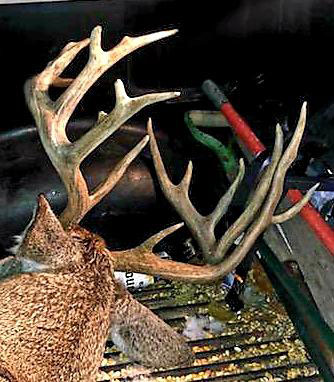 This year when I arrived in Kansas, I had an opportunity to take a very nice buck. However, this whopper had a problem, since he only had one antler. I let him go. In three different stand site sits here in Kansas, I saw 11 bucks – some fairly nice but none I really wanted to take. The place I was hunting was where I’d already put up a stand in a shelter belt. Then my Kansas hunting buddy and I decided to move me to another stand. We didn’t have a stand there, so we went in at noon, studied the deer sign there and put up a stand. After leaving the stand site, we decided not to return until later in the afternoon. I honestly can say that the 2018 season in Kansas was the coldest, windiest, snowiest season I’d ever seen there in the last 20 years. The weather was brutal.
This year when I arrived in Kansas, I had an opportunity to take a very nice buck. However, this whopper had a problem, since he only had one antler. I let him go. In three different stand site sits here in Kansas, I saw 11 bucks – some fairly nice but none I really wanted to take. The place I was hunting was where I’d already put up a stand in a shelter belt. Then my Kansas hunting buddy and I decided to move me to another stand. We didn’t have a stand there, so we went in at noon, studied the deer sign there and put up a stand. After leaving the stand site, we decided not to return until later in the afternoon. I honestly can say that the 2018 season in Kansas was the coldest, windiest, snowiest season I’d ever seen there in the last 20 years. The weather was brutal.
When I returned to that stand later that afternoon, I knew the key to taking a buck on that day would be my ability to endure the cold and bad weather. After 1-1/2 hours of sitting still, I felt like a popsicle and thought I might freeze to death. Then suddenly, I heard some noise, forgot about the cold and watched two does walk right under my stand to about 15-20 yards away before stopping. I noticed they were looking off to their right.
This region where I hunted was CRP land that had an electric fence around it put up by the landowner to keep his cattle from wandering off. But they still grazed on that CRP land. On the other side of the electric fence, I spotted a nice buck. I said to myself, “That buck looks okay, but I don’t know whether or not I want to shoot him.”
Like an idiot, I pulled my phone out of my pocket and started videoing the buck. Once the buck turned a corner to come in to where the does were, I realized that he was a whopper. I threw my phone back into my pack. I could have killed this buck but by that time, it was too late. He started running and spooked the does that then ran right behind my stand, wheeled and then ran underneath my stand.
I asked myself, “Did the buck smell me, or was he just running to the does and didn’t wind me?” I couldn’t believe I screwed up this hunt. I quickly grabbed my Quaker Boy Brawler Grunt call and grunted three times. The buck immediately stopped 60 yards away. So, I didn’t have a shot. Then he turned to look at the two does.
By this time, one of the does was out of sight, however, the other doe had circled around and returned to immediately under my stand. Looking back at the buck, I saw he was nervous and jerky while looking at the doe. I grunted at him three or four more times, and he turned around and looked my way, probably thinking another buck was trying to get with this doe. He came right back again to my stand site.
Quickly but slowly I looked at the doe under my stand. She was staring at me, like she thought she’d seen a ghost. I thought, “I can’t let this buck get to this doe. That buck will score about 160 inches, and I want to take him before he sees the doe looking at me.”
I knew I had to find a place to shoot that buck before he spotted the doe. I found one hole in the cover that was about 15 yards from my tree stand. I got my crossbow up to take this buck that was coming in quickly. When that buck walked through the end of that hole, I bleated with my mouth, the big buck stopped, and I sent my arrow on its way to meet him. I knew I’d made a double lung shot. The buck then ran about 70 yards before going down. When we finally got a tape on his antlers, he taped out at 184 1/2 inches, non-typical, the biggest deer I’d ever killed.
There is no weather except for tornadoes, hurricanes and lightning storms that are too bad to hunt for deer. Many times big bucks seem to know that hunters don’t like to hunt in bad, cold weather, so they move more frequently then without being harassed or possibly killed.
Shooting a Crossbow and Taking a Black Bear with a Compound Bow
I’ve been asked why I’ve made the switch from a compound bow to a crossbow. I had some back surgery and also had arthritis in both shoulders so bad that I had to have both shoulders replaced. I still could shoot a compound bow, but not like I once did. If I practiced shooting 8-10 arrows at 40-pound weight on my bow, I couldn’t shoot any more arrows than that. I couldn’t hold the bow back as long as I once did or have the strength I had previously. So, I’ve been hunting with a crossbow for a number of years. I really like shooting a crossbow and believe that the crossbow has enabled me to bowhunt for many more years and enjoy that sport after my three major surgeries.
Having said that, I did take a bear in 2017 with my compound bow behind my hunting camp in New York State. I had just finished salmon fishing (I guide for salmon fishing on the Lower Niagara River below the falls). In New York, you can’t hunt with a crossbow until the last two weeks of archery season. I still had my PSE compound bow with me in camp that I shot every now and then at 48 pounds.
I had a brand-new set of Mossy Oak Bottomland camouflage, but I told myself, “I’m not going to wear my new camo just to go out and sit in the woods behind my camp. I’ll just wear my old Mossy Oak I use for salmon fishing.” Although I washed those clothes in scent-free soap, they still smelled like salmon. I thought, “Oh, what the heck. I’m probably not going to see anything anyway. I’ll just go and enjoy sitting in the tree with my bow.”
I climbed into my 20-foot ladder stand, pulled my bow up and planned to relax and enjoy being in the woods. I heard a noise and didn’t recognize the cadence of whatever was walking toward my stand. Turning around, I looked and spotted a black bear. Where I hunt in my home state of New York, seeing a black bear is extremely rare. Then the bear turned and walked straight to me. I’ve taken a number of black bears in my hunting career with my bow, however this bear was special because he was on my property. The bear walked right up under my stand. I waited for the bear to step out. But while I was waiting for a shot, my stand started shaking. When I looked down under my stand, the bear’s two front paws were on the third step of my ladder stand that was in a hemlock tree. That bear was in-between the hemlock tree and my ladder stand, coming up the stand on its inside, rather than the outside. I guess he thought he’d found a fish dinner in that tree.
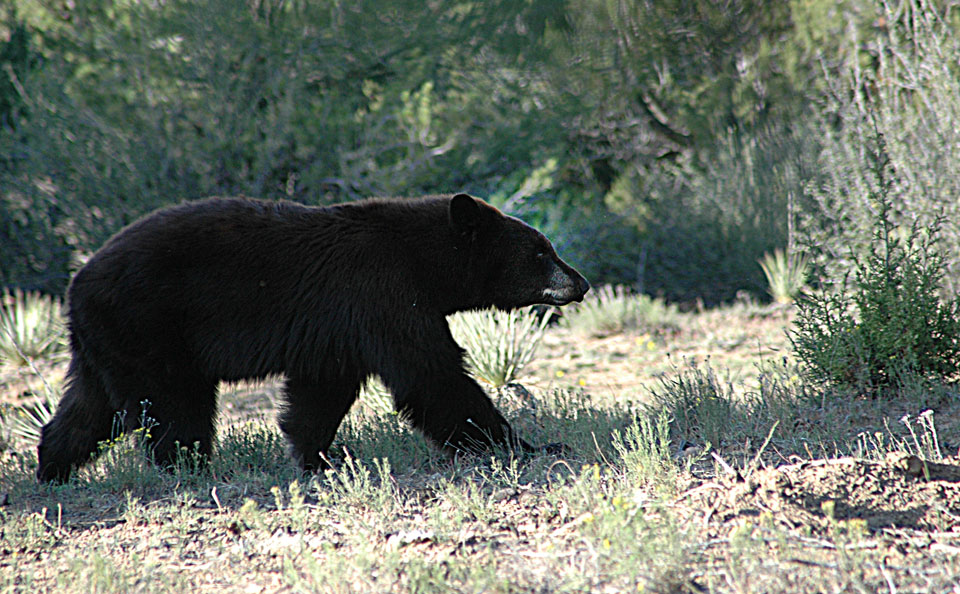
I thought, “Nobody is going to believe this.” I tried to get my phone out to take the bear’s picture. However, once the bear saw me move, he dropped off that ladder and started running. I bleated with my mouth, which gave me enough time to quickly draw my bow and aim. Once that about 200-pound bear took my arrow, he ran less than 30 yards before he went down.
I quickly learned that bears weren’t as easy to drag as deer. I went and got a couple of my buddies and a four wheeler with a winch on it. I brought another four wheeler too. We used the four wheeler with the winch to throw the cable from the winch over a limb and winched the bear up off the ground. We used the second four wheeler to put under the bear, lowered the bear down to it, tied him on to the vehicle and got the bear out of the woods.
On this hunt, I learned that sometimes dumb luck may present an opportunity you wouldn’t have had if you’d hunted smart.
Family Georgia Bowhunt, Canning Venison and Shooting a .223
Every year I try to take my 27-year-old son, Nick, bowhunting in Georgia. Nick works six months straight on road construction during the spring and summer and then is off six months during the winter months. I have a hunting buddy in Georgia who has a farm and a crop depredation permit and needs to reduce the doe population on his land as much as possible. Legally in Georgia, we can take 10 does and two bucks each during deer-hunting season. We hunt Georgia to get venison for our freezers. In 2018, we each took one buck, and I took four does, and Nick took seven does.
We can a majority of the doe meat we harvest, after grinding it, to use in a wide variety of stews, chili and burgers and cut the backstraps off to use to make venison steaks. I have a recipe I’ve been using for a number of years. We can our venison in quart or pint jars. Last year, we canned most of our venison in pints, but this year we canned most of the meat in quart jars.
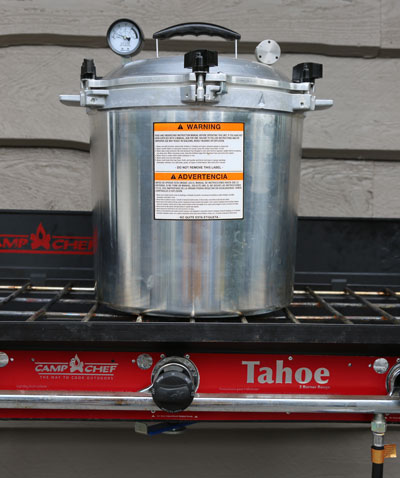 Here’s what we do. We cube the good pieces of the venison, put those in Mason or Ball jars and generally include some beef broth in the jars (you don’t have to do this). If we’re packing the venison in pint jars, we add 1/2-teaspoon of canning salt to the jars, or if we’re using quarts, we add 1 teaspoon of canning salt. I use 15 pounds of pressure on my pressure canner with about three inches of water in the cooker. I let the jars stay at 15 pounds for 1 hour, 15 minutes for pints and 1 hour, 30 minutes for quart jars. Once the canner has cooled down, and you can lift the lid off of it with no pressure, we allow the jars to cool. Then our meat is prepared. By canning, we take up no freezer space, and we can preserve our venison to eat for an extended time. I guarantee that by using this recipe we have some of the most delicious deer meat you’ll ever eat. I’ve use this canned venison through the years to make hot roast beef (venison) sandwiches, stews, shepherd’s pies, Philly cheese steak sandwiches and of course chili. But there are hundreds of ways and recipes where you can substitute canned venison instead of using beef, pork and chicken.
Here’s what we do. We cube the good pieces of the venison, put those in Mason or Ball jars and generally include some beef broth in the jars (you don’t have to do this). If we’re packing the venison in pint jars, we add 1/2-teaspoon of canning salt to the jars, or if we’re using quarts, we add 1 teaspoon of canning salt. I use 15 pounds of pressure on my pressure canner with about three inches of water in the cooker. I let the jars stay at 15 pounds for 1 hour, 15 minutes for pints and 1 hour, 30 minutes for quart jars. Once the canner has cooled down, and you can lift the lid off of it with no pressure, we allow the jars to cool. Then our meat is prepared. By canning, we take up no freezer space, and we can preserve our venison to eat for an extended time. I guarantee that by using this recipe we have some of the most delicious deer meat you’ll ever eat. I’ve use this canned venison through the years to make hot roast beef (venison) sandwiches, stews, shepherd’s pies, Philly cheese steak sandwiches and of course chili. But there are hundreds of ways and recipes where you can substitute canned venison instead of using beef, pork and chicken.
One of the things we’re famous for up here in New York is Beef on a Weck, which usually is thin-sliced roast beef cooked rare and put on a hard kummelweck roll that’s similar to a crusty Kaiser roll and sprinkled with caraway and coarse salt. The top bun gets a dip au jus and is spread with horseradish. But instead of using beef, we use the canned deer meat, and the sandwich is very delicious and flavorful.
The Georgia buck I took in 2018 was an 11-pointer. On this year’s hunt, we didn’t see numbers of deer because we were hunting with a full moon at night. We hunted for 3-1/2 days, and I was in one of my favorite stands when a doe appeared. I shot her. Then two bucks and a fawn walked out and went all the way down the edge of the field. The buck in the back was a nice buck for the property where we were hunting. So, I shot him with a .223 rifle that I’d borrowed to try out. I really liked how well it shot. Every deer I shot with that gun dropped right in its tracks, possibly because I shot them all in their necks, aiming right at where the head and the neck met. This gun was incredibly accurate.
I learned while hunting in Georgia that if you have an accurate rifle and aren’t taking very long shots, a small rifle like a .223 can do the job quickly and efficiently without much recoil.














